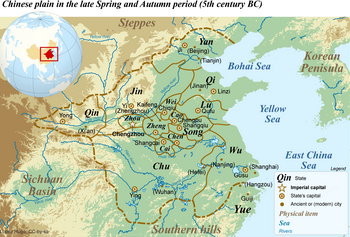This article should specify the language of its non-English content, using {{lang}}, {{transliteration}} for transliterated languages, and {{IPA}} for phonetic transcriptions, with an appropriate ISO 639 code. Wikipedia's multilingual support templates may also be used. (November 2024) |
| Old Yue | |
|---|---|
| Yue | |
| Native to | Yue, Dong'ou, Minyue, Nanyue |
| Region | Southern China |
| Ethnicity | Baiyue |
| Extinct | c. 1st century AD |
| Language codes | |
| ISO 639-3 | None (mis) |


The Old Yue language (Chinese: 古越語; pinyin: Gǔyuè yǔ; Jyutping: Gu2 Jyut6 Jyu5; Pe̍h-ōe-jī: Kó͘-oa̍t-gí / Kó͘-oa̍t-gír / Kó͘-oa̍t-gú, Vietnamese: Tiếng Việt cổ) is an unattested, unclassified language, or group(s) of various languages, spoken in ancient southern China, and northern Vietnam circa 700 BCE or later. It can refer to Yue, which was spoken in the realm of Yue during the Spring and Autumn period, or to the different languages spoken by the Baiyue. Possible languages spoken by them may have been of Kra–Dai, Hmong–Mien, Austronesian, Austroasiatic and other origins.
Knowledge of Yue speech is limited to fragmentary references and possible loanwords in other languages, principally Chinese. The longest attestation is the Song of the Yue Boatman, a short song transcribed phonetically in Chinese characters in 528 BC and included, with a Chinese version, in the Garden of Stories compiled by Liu Xiang five centuries later.[1]
Native Nanyue people likely spoke Old Yue, while Han settlers and government officials spoke Old Chinese. Some suggest that the descendants of the Nanyue spoke Austroasiatic languages.[2] Others suggest a language related to the modern Zhuang people. It is plausible that the Yue spoke more than one language. Old Chinese in the region was likely much influenced by Yue speech (and vice versa), and many Old Yue loanwords in Chinese have been identified by modern scholars.[3]
- ^ Zhengzhang 1991, pp. 159–168.
- ^ Loewe, Michael; Shaughnessy, Edward L. (1999-03-13). The Cambridge History of Ancient China: From the Origins of Civilization to 221 BC. Cambridge University Press. ISBN 9780521470308.
- ^ Zhang & Huang, 320-321.
